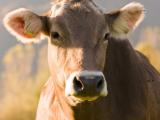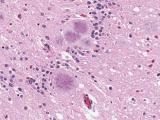Jun 27, 2006 (CIDRAP News) Canada announced yesterday it will ban cattle parts that could spread bovine spongiform encephalopathy (BSE) from all animal feeds, pet foods, and fertilizers, making Canada's restrictions tighter than those in the United States.
The new rules will take effect in July 2007, but smaller businesses will get an additional 6 months to comply, the Canadian Food Inspection Agency (CFIA) said in its announcement. The rules apply to "specified risk materials" (SRMs) from older cattlethe brain, spinal cord, and certain other tissues that are likely to contain the infective agent if an animal has the disease.
To prevent the spread of BSE, Canada, like the United States, currently bans the use of protein from cattle and other ruminant animals in ruminant feeds. But cattle protein can be used in feed for nonruminants such as horses, swine, and poultry. (Both countries also ban the use of SRMs in human food.)
The aim of keeping SRMs out of all animal feeds is to prevent contamination of cattle feed with other feeds containing potentially infective materials, the CFIA said. Removing SRMs from pet food and fertilizers is intended to lower the chance that misuse of these products would expose cattle and other susceptible animals to BSE, or mad cow disease.
"This ban tightens already strong, internationally recognized feed controls and shortens the path we must follow to move beyond BSE," said Chuck Strahl, minister of agriculture and minister for the Canadian Wheat Board, in the CFIA news release.
"Materials known through science to pose risk to animals can no longer get into the feed supply of any animal in Canada," said Brian Evans, the CFIA's chief veterinarian, as quoted in a Bloomberg news report yesterday.
The US Food and Drug Administration (FDA) is currently working on a more limited feed-ban expansion: banning older cattle's brains and spinal cords from all animal feeds and pet foods. The agency proposed the new rule last October and is currently analyzing about 800 public comments on it. The rule would not apply to other SRMs, such as the tonsils, eyes, and certain nerve bundles, and it would not cover fertilizer.
"After FDA considers the public comments on the proposal issued in October 2005, the agency and HHS [the Department of Health and Human Services] plan to develop and issue a final rule as expeditiously as possible," the FDA said in a statement yesterday.
Five BSE cases have been discovered in Canada, the first of them in May 2003 and the last one in British Columbia in April. The United States has had three cases, two of them in Canadian-born cattle. The most recent case, found in Alabama in March, involved a native-born cow.
The full list of SRMs covered by the new Canadian rule includes the skull, brain, eyes, tonsils, spinal cord, trigeminal ganglia (nerves attached to the brain), and dorsal root ganglia (nerves attached to the spinal cord) of cattle aged 30 months or older, plus the distal ileum (part of the small intestine) of cattle of all ages.
In a fact sheet, the CFIA said the primary goal of the new restrictions is to eliminate "99% of potential infectivity from entering the feed system." The agency said affected businesses could be exempted from the restrictions if they can find another documented way to achieve the same result.
"The default method for achieving this objective is the removal of all SRM; however, regulated parties may develop and propose alternative approaches, with supporting scientific data, that can be shown to achieve the same level of protection as full SRM removal," the agency said.
The Canadian government has set aside $80 million to work with the provinces to help the affected industries comply with the new rules, the CFIA said. Over the next year, the agency plans to work on informing regulated firms, especially small slaughterhouses, about the restrictions and helping them comply.
The CFIA said it will use a permit system to control the collection, treatment, and disposal of SRMs. For now, the materials are expected to be buried in landfills or burned, but the agency expects that alternatives such as using them to make biofuels will eventually emerge.
Evans predicted that the new measures will eliminate BSE from Canadian cattle in 10 years or less, according to the Bloomberg report. The rules will also help reopen export markets for Canadian cattle and feed, he said.
The FDA, in proposing an expanded US feed ban last October, estimated that about 64 million pounds of cattle brains and spinal cords would have to be disposed of in new ways under the proposal. Banning all SRMs from animal feed and pet food would produce a much large increase in waste material, the agency said.
See also:
FDA June 26 statement on the new Canadian rule
http://www.fda.gov/NewsEvents/Newsroom/PressAnnouncements/2006/ucm108678.htm
Oct 4, 2005, CIDRAP News story "FDA to ban some cattle parts from animal feed"



















